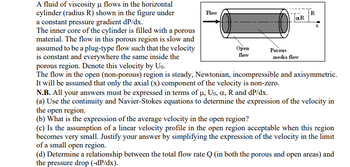A fluid of viscosity μ flows in the horizontal cylinder (radius R) shown in the figure under a constant pressure gradient dP/dx. The inner core of the cylinder is filled with a porous material. The flow in this porous region is slow and assumed to be a plug-type flow such that the velocity is constant and everywhere the same inside the porous region. Denote this velocity by Uo. The flow in the open (non-porous) region is steady, Newtonian, incompressible and axisymmetric. It will be assumed that only the axial (x) component of the velocity is non-zero. Flow Open flow Porous αR media flow R X N.B. All your answers must be expressed in terms of μ, Uo, a, R and dp/dx. (a) Use the continuity and Navier-Stokes equations to determine the expression of the velocity in the open region. (b) What is the expression of the average velocity in the open region? (c) Is the assumption of a linear velocity profile in the open region acceptable when this region becomes very small. Justify your answer by simplifying the expression of the velocity in the limit of a small open region. (d) Determine a relationship between the total flow rate Q (in both the porous and open areas) and the pressure drop (-dP/dx).
A fluid of viscosity μ flows in the horizontal cylinder (radius R) shown in the figure under a constant pressure gradient dP/dx. The inner core of the cylinder is filled with a porous material. The flow in this porous region is slow and assumed to be a plug-type flow such that the velocity is constant and everywhere the same inside the porous region. Denote this velocity by Uo. The flow in the open (non-porous) region is steady, Newtonian, incompressible and axisymmetric. It will be assumed that only the axial (x) component of the velocity is non-zero. Flow Open flow Porous αR media flow R X N.B. All your answers must be expressed in terms of μ, Uo, a, R and dp/dx. (a) Use the continuity and Navier-Stokes equations to determine the expression of the velocity in the open region. (b) What is the expression of the average velocity in the open region? (c) Is the assumption of a linear velocity profile in the open region acceptable when this region becomes very small. Justify your answer by simplifying the expression of the velocity in the limit of a small open region. (d) Determine a relationship between the total flow rate Q (in both the porous and open areas) and the pressure drop (-dP/dx).
Oh no! Our experts couldn't answer your question.
Don't worry! We won't leave you hanging. Plus, we're giving you back one question for the inconvenience.
Submit your question and receive a step-by-step explanation from our experts in as fast as 30 minutes.
You have no more questions left.
Message from our expert:
Our experts are unable to provide you with a solution at this time. Try rewording your question, and make sure to submit one question at a time. A question credit has been added to your account for future use.
Your Question:

Transcribed Image Text:A fluid of viscosity μ flows in the horizontal
cylinder (radius R) shown in the figure under
a constant pressure gradient dP/dx.
The inner core of the cylinder is filled with a porous
material. The flow in this porous region is slow and
assumed to be a plug-type flow such that the velocity
is constant and everywhere the same inside the
porous region. Denote this velocity by Uo.
The flow in the open (non-porous) region is steady, Newtonian, incompressible and axisymmetric.
It will be assumed that only the axial (x) component of the velocity is non-zero.
Flow
Open
flow
Porous
αR
media flow
R
X
N.B. All your answers must be expressed in terms of μ, Uo, a, R and dp/dx.
(a) Use the continuity and Navier-Stokes equations to determine the expression of the velocity in
the open region.
(b) What is the expression of the average velocity in the open region?
(c) Is the assumption of a linear velocity profile in the open region acceptable when this region
becomes very small. Justify your answer by simplifying the expression of the velocity in the limit
of a small open region.
(d) Determine a relationship between the total flow rate Q (in both the porous and open areas) and
the pressure drop (-dP/dx).
Knowledge Booster
Learn more about
Need a deep-dive on the concept behind this application? Look no further. Learn more about this topic, mechanical-engineering and related others by exploring similar questions and additional content below.Recommended textbooks for you

Elements Of Electromagnetics
Mechanical Engineering
ISBN:
9780190698614
Author:
Sadiku, Matthew N. O.
Publisher:
Oxford University Press

Mechanics of Materials (10th Edition)
Mechanical Engineering
ISBN:
9780134319650
Author:
Russell C. Hibbeler
Publisher:
PEARSON

Thermodynamics: An Engineering Approach
Mechanical Engineering
ISBN:
9781259822674
Author:
Yunus A. Cengel Dr., Michael A. Boles
Publisher:
McGraw-Hill Education

Elements Of Electromagnetics
Mechanical Engineering
ISBN:
9780190698614
Author:
Sadiku, Matthew N. O.
Publisher:
Oxford University Press

Mechanics of Materials (10th Edition)
Mechanical Engineering
ISBN:
9780134319650
Author:
Russell C. Hibbeler
Publisher:
PEARSON

Thermodynamics: An Engineering Approach
Mechanical Engineering
ISBN:
9781259822674
Author:
Yunus A. Cengel Dr., Michael A. Boles
Publisher:
McGraw-Hill Education

Control Systems Engineering
Mechanical Engineering
ISBN:
9781118170519
Author:
Norman S. Nise
Publisher:
WILEY

Mechanics of Materials (MindTap Course List)
Mechanical Engineering
ISBN:
9781337093347
Author:
Barry J. Goodno, James M. Gere
Publisher:
Cengage Learning

Engineering Mechanics: Statics
Mechanical Engineering
ISBN:
9781118807330
Author:
James L. Meriam, L. G. Kraige, J. N. Bolton
Publisher:
WILEY
